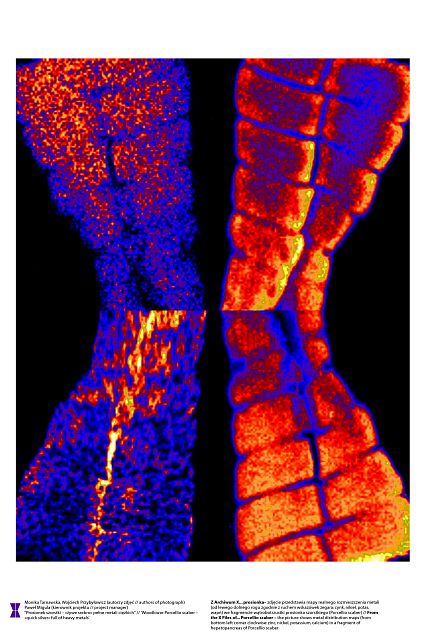 |
'Woodlouse Porcellio scaber - »quick silver« full of heavy metals'
'Selected indicators of chemical stress and profiles of detoxifying enzymes dependent on hepatopancreas and digestive tract glutathione in Porcellio scaber Latr. (Isopoda: Oniscidea) in chronical nickel intoxication' MONIKA TARNAWSKA1, WOJCIECH PRZYBYŁOWICZ2 (authors of photograph)
PAWEŁ MIGULA (project manager)
1 University of Silesia, Faculty of Biology and Environmental Protection,
Department of Animal Physiology and Ecotoxicology; Bankowa 9, 40-007 Katowice
e-mail: dybowska@us.edu.pl
2 Materials Research Group, iThemba LABS, Somerset West 7129, RSA
|

Description popularizing the research project
It does not look very impressive, just a tiny, merely 18-milimeter-long, oval, grey creature with distinct segments of a carapace and numerous legs. A woodlouse runs quietly on its 14 legs when the dusk settles down. Encountered it resembles a small cockroach although it is a closer relative of crabs than of any insects. It is rarely seen even though we pass it by every day in cellars and garages where it lives. It is not a difficult neighbor for us. It is defenseless and does not make any noise it, is not aggressive at all and helps us get rid of litter by simply eating it. Moreover woodlice do not listen to heavy metal but have a lot of to do with heavy metals. This modest creature has a feature which makes it great in scientists' opinion. When forced to feed on food contaminated with heavy metals it stores the burden in the tissue of hepatopancreas for the rest of its 3-year-long life. Each meal in the vicinity of steelworks, a highway or in the very heart of Upper Silesian Industrial Region increases concentration of heavy metals in its body. A woodlouse's menu expressed in colorful spots in a picture of a proton beam is a valuable source of information for ecotoxicologists, making the creature the main character of scientific dissertations, and academic books.
Let us know our neighbor who is not scared of our activities changing natural ecosystems. Can we do anything for it having appreciated its virtues? Yes, indeed. We can leave a few rotting planks, a handful of leaves and some stones in the garden to help the woodlice survive another winter.
Abstract
The general aim of this project was, basing on laboratory experiments, to discuss specificity of physiological and biochemical mechanisms in terrestrial crustacean Porcellio scaber which are started up in reaction to toxic nickel influence. From many previous researches concerning the role of these animals in leaf litter layer decomposition in heavy metal polluted environments we know, that their high metal concentration tolerance results from their ability to bioconcentrate metal in their tissues selectively, especially in hepatopancreas. So far a lot of data about lead, cadmium, zinc and copper influence has been available, but there is lack of studies on sublethal effects of nickel interactions.
Detailed aims of the research were:
- How nickel and some others elements are distributed in a digestive tract and hepatopancreas of P. scaber in chronic exposition to nickel contaminated food?
- How the ultastructure of a digestive tract and hepatopancreas of P. scaber is changed under different nickel concentrations?
- To what a degree differential supply of nickel in food affects catalase activity (CAT) and glutathione dependent enzymes (selenium-dependent (GPOX) and selenium-independent glutathione peroxidase (GSTPX), glutathione reductase (GR), glutathione S-transferase (GST)) and glutathione level (GSH) in a digestive tract and hepatopancreas of P. scaber?
- How presence of nickel in food affects body mass changes in these animals?
- How level of expression of heat shock proteins (hsp70) is changed depending on amount of nickel in food in a digestive tract and hepatopancreas of P. scaber?
As a result of this project some good biomarkers like activity of some glutathione dependent enzymes (GPOX, GSTPX, GR) which are useful in estimating toxic influence of this metal in P. scaber were established,. Activity of these enzymes has exerted strict dependence on concentration of nickel in food and in tissues in P. scaber. There was similarity in case of level of accumulation of nickel in hepatopancreas and alterations of a cellular structure of hepatopancreas and a digestive tract influenced by this metal. It was shown that body mass as well as hsp70 stress proteins expression are not good parameters to define toxic nickel influence.

